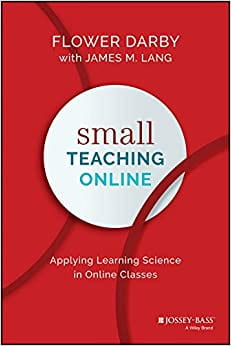An Online Pedagogy Reading Circle Sponsored by the OIT Mentors, led by Andrew Higgins
In the online course, a number of factors complicate our responses to student work. We often don’t have a face-to-face relationship with the students, which can complicate the emotional tone (and the way students perceive the emotional tone) of our responses. Asynchronous courses lack the regular rhythm of class meetings, making it easier to slip behind on grading. And perhaps most important factor is that there’s just so much more work to respond to! So teaching online requires both special attention both to the ways students receive our responses and the way we manage our workload.
In this reading circle, we will discuss Flower Darby’s chapter, “Giving Feedback” from Small Teaching Online, which explores several of the issues online teachers must address when giving feedback. The chapter explores the differences between summative and formative assessment, the tension between timeliness and thoroughness in feedback, ways to promote live feedback via audio or video, and the importance of using rubrics to streamline grading and make it more effective.
We’ve all given feedback to students, and we all have things that work well for us and things that, well, don’t work so well. So join us to share your successes and struggles responding to student work in the online environment and to hear from your colleagues about their approaches to feedback. Hopefully we’ll all come away with some practical ideas about how to make the feedback we give to our students more effective and more manageable.
Here is Small Teaching Giving Feedback
Date: Wed. March 30
Time: 12:00 – 1:00 p.m.
Location: WebEx
Earlier session…… in
An Online Pedagogy Reading Circle Sponsored by the OIT Mentors, led by Andrew Higgins
One of the most exciting pedagogical ideas of the past twenty-five years is the concept of backwards design, the idea that teachers should begin course planning with a clearly articulated end point—an outcome they want students to achieve—and then design every facet of the course to point students toward that goal. This idea is especially crucial for online courses, which can seem confusing, disorienting, and overwhelming to students.
But “design” seems to suggest that we are starting with a new course. Most of us, however, are re-designing courses we have already taught multiple times, and we don’t necessarily have the time to start over from the beginning. So how do you apply backwards design to a course you’ve already designed?
In this reading circle, we will discuss Flower Darby’s chapter, “Surfacing Backwards Design” from Small Teaching Online, which explores ways teachers can incorporate backwards design into existing courses without having to tear those courses down and start from the beginning. We will start our discussion with a short overview of the idea of backwards design and its importance for online teaching, and then move on to a discussion of practical, small steps we can take to align our existing courses with backwards design principles so that our students will have a clearer understanding of why they are doing the crazy things we ask them to do in our courses.
Join us for a relaxed discussion and some practical ideas about how to backwards design your courses.
Recommended Reading for March 30 TBD
Recommended Reading for March 2:
Small_Teaching_Surfacing_Backward_Design) (1):
Date: Wednesday, March 2
Time: 12:00 – 1:00 p.m.
Location: WebEx






